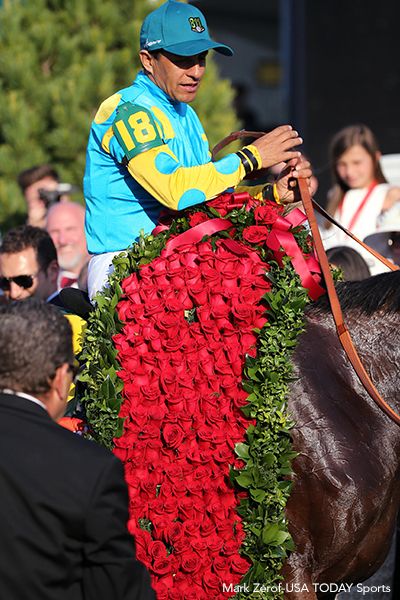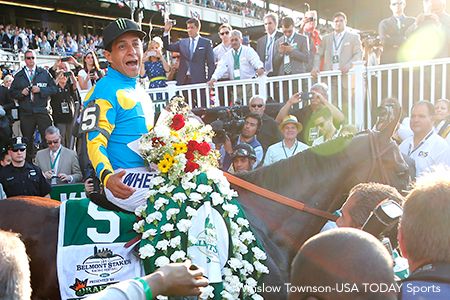Maybe horse racing's most watched trifecta should be called the "Flower Crown." After all, there isn't a jewel in sight on the horses at the Kentucky Derby, Preakness or Belmont Stakes. There are, however, hundreds, if not thousands of flowers draped over the winners' backs while jockeys raise gleaming trophies.
Legend has it, the Triple Crown got its name from a Daily Racing Form columnist after Gallant Fox won all three races in 1930, and after decades of use, most countries use the moniker for their own series of stakes races. The New York Times, however, would like a little credit, too, claiming to have used the phrase at least seven years prior.

Either way, the true jewels of the race may well be the hand-made flower blankets – roses for the Kentucky Derby, black-eyed Susans for the for the Preakness and white carnations for the Belmont. The blankets are intricate works of art in their own right – though one is a fraud.
The most elaborate of the three blankets is the rose-covered garland awarded at the Kentucky Derby. While roses have no real connection to Kentucky, the flowers were given away at Derby parties as far back as the late 1800s. It wasn’t until about 1904 that the race itself embraced the flower.
According to the Kentucky Derby website, the first rose garland was awarded in 1896, when a pink-and-white arrangement was given to winner Ben Brush. The Derby made the red rose – it now uses a specific red rose called the "Freedom Rose" in memory of 9-11 – its official flower in 1904 and 21 years later, sports columnist Bill Corum nicknamed the race the "Run for the Roses."
In 1932, the current garland, which is made up of 400 roses selected from more than 7,000, was introduced. Before this, winners were often handed a horseshoe of roses in the winner's circle.
The hand-selected roses are each individually sewn onto green satin that bears the seal of the Commonwealth of Kentucky at one end and the Twin Spires of Churchill Downs at the other. At the center of the blanket is a crown of roses, green fern and hand-formed ribbon, including a single rose pointing to the sky. The number of roses in the "crown" varies from year to year based on the number of entries in the race. But that single rose "symbolizes the struggle and heart necessary to reach the Kentucky Derby winner’s circle," according to the Derby website video "Traditions – The Garland of Roses."

The making of the garland is a public and festive occasion in Louisville. Designed and put together by master floral designers from the Kroger grocery store chain, the blanket is made at a local Kroger store and is on display the night before the race. The rose blanket takes up to 12 hours to construct, is 122 inches long, 22 inches wide and weighs 40 pounds.
After wearing the rose garland, the Kentucky Derby winner usually heads to Baltimore, where the Preakness Stakes and second jewel of the crown await. The Preakness winner is draped with a black-eyed Susan blanket – except the black-eyed Susans are fakes. The black-eyed Susan, which is the Maryland state flower, doesn't bloom until June, so the Preakness garland is made of mums dabbed with black lacquer to give the appearance of black-eyed Susans, which are members of the daisy family.
Like the Derby blanket, the Preakness garland is made at a local grocery story – a Giant in this case – but it takes about 10 times more flowers than the Derby blanket. A wire is inserted into the cut stem of each flower and it is then attached to black matting, which is backed with green felt so the wires do not injure the winning horse. The Preakness garland is smaller than its Kentucky cousin, measuring 90-by-18 inches.

Above the garland, the Preakness-winning jockey will hold up the silver Woodlawn Vase, designed by Tiffany & Co. in 1860 and valued at well over $1 million.
The final jewel in the Triple Crown, the Belmont Stakes, adorns its winner with a white-carnation blanket made of 700 carnations imported from Colombia. The flower, like the Derby rose, has no real connection to the race or the state of New York. The 40-pound blanket is made annually by New York Racing Association florist Tony Green, who glues each of the carnations to seven yards of green velvet cloth. Green says it takes him about five hours to make the blanket – which he assembles on race day after soaking the stems for two days. Green also makes a second blanket that is draped over the Secretariat statue at Belmont.
Popular On ThePostGame:
-- Seven-Year-Old Cancer Survivor Gets Chicago Cubs Prosthetic Eye
-- You, Me And Ali: Don't Need To Be Boxing Fan To Love 'The Greatest'
-- Sharks Announcer Reflects On Franchise's Remarkable Journey To Cup Final





